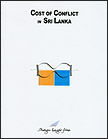Cost of Conflict in Sri Lanka, 2006
 |
ISBN No. 818826208-0
Excerpts:
The twenty-five year long military conflict between the Tamil insurgents and successive Sri Lankan governments has made Sri Lanka the most militarised country in South Asia. In this respect, Sri Lanka has dwarfed the much larger India and military-ruled Pakistan. Published in January 2006, the Cost of Conflict in Sri Lanka notes that Sri Lanka will continue to hold this dubious position between now and 2010, given the absence of any clear signs that the military conflict is going to taper off. Further, presenting comparative data for 2004, Sri Lanka was the most militarised among the South Asian countries with 8,000 military personnel per one million population. In terms of military expenditure as percentage of GDP also, Sri Lanka spent the most. Sri Lanka's defence expenditure is also higher than other comparable conflict-ridden countries such as Colombia, Myanmar, Sierra Leone, Sudan, the Philippines and Uganda.
On the other hand, LTTE's annual expenditure on its cadres and military-oriented networks, both in the island and abroad, is estimated to be in the range of $8 million annually.But given the fact that the outfit's annual income is anywhere between $175 million and $385 million, the expenditure on cadres and the informer networks is nsignificant. The LTTE spends a minimum on its cadres and the maximum on sustaining a war economy and its support base internationally. It is believed that of the total income, $100 million to 250 million comes from drug trafficking, though there is yet no direct evidence of the LTTE's involvement in this trade. Local taxation and extortion is said to contribute about $30 million; human smuggling and funds siphoned off from NGOs gives $3 to 5 million; contributions from the Tamil expatriate community fetches $40 to 50 million; and profits from businesses from $35 to 50 million.
These are only a few of the findings, and analysis of the costs of conflict to Sri Lanka. The Cost of Conflict in Sri Lanka enumerates the past, present and the future costs associated with the Sri Lankan conflict. The prolonged conflict has also polarized Sri Lankan society across ethnic, religious and regional divides placing the country’s social fabric under considerable strain. What does the future hold for Sri Lanka? How long will the current status quo last? Will the LTTE face more rebellion from within its ranks in case of a prolonged status quo? Will the LTTE continue with the peace process if their demand for an Interim Self-Governing Authority for the northeast is not fulfilled soon? Will the Sri Lankan political parties overcome their differences to find a permanent solution to the conflict? Will the Sri Lankan government be successful in formulating a solution acceptable to its Sinhalese, Tamil and Muslim populations? The Cost of Conflict in Sri Lanka provides three scenarios for the island country for the period of 2006-2010 and beyond.
related media coverage
-
Imperative for Peace in Sri Lanka
January 29, 2007
-
Peace eludes Sri Lanka - Over-Militarisation Gives False Hope To Rajapaksa
October 12, 2006
-
Conflicting signals
October 07-20, 2006
-
Sri Lanka
September 29, 2006
-
South Asia’s most militarised society
September 28, 2006
-
South Asia's most militarised society
September 27, 2006
-
Most militarised nation in South Asia!
September 23, 2006
-
Lanka Most Militarized in South Asia: Study
September 21, 2006
-
Imperative For Peace In Sri Lanka
March 03, 2006


